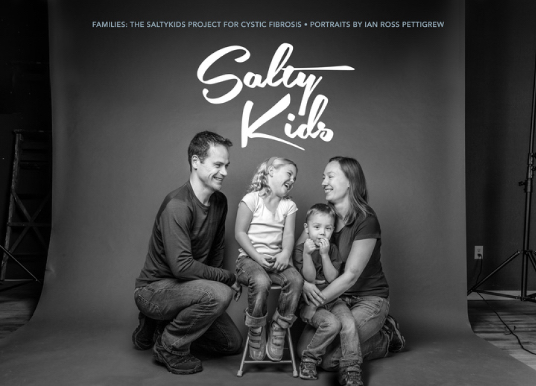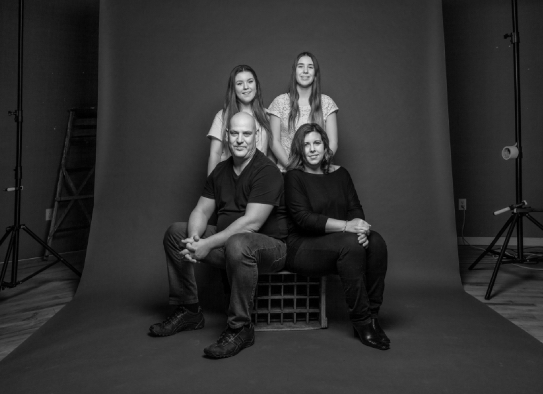‘Salty Kids’ to Capture Challenges of Children and Families Living with Cystic Fibrosis
Written by |

Ian Ross Pettigrew, the Hamilton, Ontario-based photographer and the creator of the Salty Girls photo project and book of the same name, is carrying on with the next stage of his project: capturing images of people living with cystic fibrosis (CF). Salty Kids will containing a gallery of images of children with CF and, sometimes, their parents and siblings. Pettigrew has been raising funds to finance the book project with an IndieGoGo crowdfunding initiative, with shooting likely to begin in late spring or early summer 2016.
Photo courtesy of Ian Ross Pettigrew
Pettigrew himself was diagnosed with cystic fibrosis nine years ago at age 38, presenting, as he puts it, something of a “medical anomaly,” having received a CF diagnosis (which usually happens at birth) at that advanced age, and never really having experienced any major symptoms.
Growing frustrated that dialogue surrounding CF was focused primarily on parents and children, Pettigrew launched his first CF photography project: “Just Breathe,” a book focused on adults living with CF, and their particular issues, problems, and feelings. The book was aptly named, as the genetic disease causes mucus to build up and clog organs in the body, mainly the lungs and pancreas.
 During the making of “Just Breathe,” Pettigrew says he started hearing about other issues impacting adults living with CF, particularly among women with the disease, which inspired him to begin work on his second book: “Salty Girls.” The book contains photos of 77 women, taken with their own clothing and posing in more than 25 cities. Pettigrew notes that by the summer of 2015 — even before the book was out — the Salty Girls idea went viral globally. As he wrote in its introduction: “I know what these woman go through on a daily basis; every day is a struggle living with CF. And, to the uninformed, it’s an invisible fatal disease. With this book it’s invisible no more. The stories here are real and powerful. Its the Salty Girls, in their own words.”
During the making of “Just Breathe,” Pettigrew says he started hearing about other issues impacting adults living with CF, particularly among women with the disease, which inspired him to begin work on his second book: “Salty Girls.” The book contains photos of 77 women, taken with their own clothing and posing in more than 25 cities. Pettigrew notes that by the summer of 2015 — even before the book was out — the Salty Girls idea went viral globally. As he wrote in its introduction: “I know what these woman go through on a daily basis; every day is a struggle living with CF. And, to the uninformed, it’s an invisible fatal disease. With this book it’s invisible no more. The stories here are real and powerful. Its the Salty Girls, in their own words.”
Photo courtesy of Ian Ross Pettigrew
Like with a good movie trilogy, says Pettigrew, now it’s time to move on to a third work. This book, officially titled “Families: The SaltyKids Project For Cystic Fibrosis” but becoming known as simply “SaltyKids,” focuses on children with CF and their families, documenting in a studio portrait sessions the children (sometimes with family members) as they experience the challenges of coping with their incurable disease. The book, importantly, also gives parents of CF children — the frontline caregivers — a say, letting them speak of their struggles in coping with CF symptoms, which can include persistent coughing with thick mucus, wheezing, shortness of breath, lung infections, inflamed nasal passages, poor weight gain and growth, intestinal blockage, and severe constipation.
“After the success of ‘SaltyGirls,'” Pettigrew told Cystic Fibrosis News Today, “it was time for me to change my focus for my project. I wasn’t short of ideas — especially ideas from others (like SaltyGuys) — but I wanted something different. I had been able to first tell the stories of adults living with cystic fibrosis; then I was able to give women a voice and shift the perspective; but I wondered what was the perspective of those caring for someone with CF.”
Photo courtesy of Ian Ross Pettigrew
“Cystic fibrosis is (almost) unlike any other disease,” Pettigrew says. “You are born with it … and at that moment the clock is ticking. Cystic fibrosis is a fatal disease, with the median life [span of sufferers] in the U.S. only in the early 40s. That’s something hard to wrap your head around as a parent.
“It’s also a lifelong commitment to treatments, hospitalizations, possible transplants … a lifelong burden of medical bills and sleepless nights. I want to give the parents a voice in this.”
As for where the “salty” part comes in, Pettigrew says that the “sweat test,” which measures the concentration of chloride in perspiration, has been the gold standard for diagnosing CF for more than 50 years. People with CF have more chloride (salt) in their sweat than those who don’t have CF. In CF patients, the CFTR chloride channel is defective, and does not allow chloride to be reabsorbed into sweat duct cells. Consequently, more sodium stays in the duct, and more chloride remains in the sweat.
Pettigrew adds that the concentration of sodium in sweat is also elevated in CF patients, but unlike with the CFTR chloride channels, sodium channels behave normally in CF. However, in order for the secretion to be electrically neutral, positively charged sodium cations remain in the sweat along with the negatively charged chloride anions. In this way, the chloride anions are said to “trap” the sodium cations.
Hence, “salty.”
While there is currently no cure for CF, Pettigrew is hopeful that between the advances being made in current treatments and promising genetic therapies, the medical profession is on the cusp of an actual cure. He thinks that those diagnosed with CF today have a bright future — despite the inevitable bumps along the way, bumps that the entire family has to endure.
“And taking a large brunt of this — emotionally, financially — are the parents raising a child with CF,” he says. “That is what this project will be focused on. The daily trials and tribulations — as well as hopes and dreams — of those families.”
For more information, visit www.saltykidsproject.com and www.indiegogo.com/projects/families-the-saltykids-project.
Sources:
FAMILIES: The SaltyKids Project
Salty Girls
Ian Ross Pettigrew








